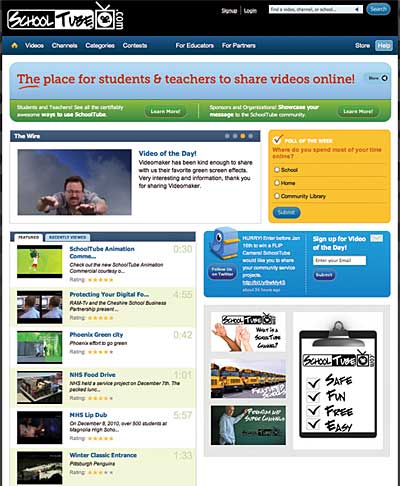Educational Video in 2011
The Lecture Capture Challenge
One area that still presents a challenge for many educators is the integration of lecture capture with online video platforms. Lecture capture systems have been so popular in education because they offer a turnkey option for recording and serving video with a simplified user experience. As part of that experience, all major capture systems include a portal for managing and accessing lecture videos. Most now offer a way to upload into the portal video files that were not recorded by the capture system. However, this functionality can be bare-bones, lacking advanced options such as server-side transcoding that come with OVPs.
Lecture capture videos often are composed of synchronized media elements, such as image files or multiple videos. Therefore, the full multimedia product is not always easily imported into an OVP. In many cases an additional stand-alone video must be exported from the lecture capture system, requiring an additional step and processing time. This is a challenge that several lecture capture vendors, including Echo360 and Accordent, are addressing. Nevertheless, because lecture capture systems have been on the scene longer, schools with large archives of captured content are faced with the question of how to merge these assets with newly adopted OVPs.
I expect that we will see more solutions to this problem in the near future. It’s simply in the best interest of both lecture capture and OVP vendors to help schools create a single online video ecosystem. The big question will be which vendor provides the foundation for that ecosystem.
Lecture capture using just a desktop client, or even a browser plug-in, is a function that is increasingly available for OVPs. While webcams and plug-ins do not necessarily provide the same degree of production quality and flexibility as dedicated capture hardware and software can, the cost differential can be significant, especially for schools that don’t already have lecture capture investments.
At the same time, we’re seeing a broader set of management tools on offer from lecture capture vendors. For instance, Accordent has expanded its Media Management System (AMMS) to handle a greater array of video assets alongside content from its lecture capture system. With AMMS version 4.0, which was released at the end of 2010, Accordent added integration with Microsoft SharePoint, bringing together media management with enterprise collaboration and file sharing.
Video (Almost) Everywhere
 Not to be forgotten in any discussion of the state of video in education is the role of video creation in the teaching and learning process. There’s constantly increasing use of student-generated video for evaluation purposes. In fact, an education-only version of YouTube, SchoolTube, has been on the scene since 2007, permitting students and teachers to post and share videos. Unlike other OVPs, SchoolTube is for K–12 schools only, and it’s moderated for that specific audience of students, teachers, and even parents. In its 3 years on the web, the platform has partnered with such education groups as the American Association of School Librarians, the Association for Career and Technical Education, and the National Association of Elementary School Principals.
Not to be forgotten in any discussion of the state of video in education is the role of video creation in the teaching and learning process. There’s constantly increasing use of student-generated video for evaluation purposes. In fact, an education-only version of YouTube, SchoolTube, has been on the scene since 2007, permitting students and teachers to post and share videos. Unlike other OVPs, SchoolTube is for K–12 schools only, and it’s moderated for that specific audience of students, teachers, and even parents. In its 3 years on the web, the platform has partnered with such education groups as the American Association of School Librarians, the Association for Career and Technical Education, and the National Association of Elementary School Principals.
As more students create videos, these assets become evidence of their academic achievement that can be of value for college admissions or the job market. Many schools, especially colleges of education, have implemented e-portfolios to help students manage, track, and securely share these assets. The need for this service will spread across disciplines and levels of school, including K–12 and 2-year colleges. Students will encounter different platforms as they move on from one school to another, so it will also become more important that they be able to preserve and archive their creations, whether by exporting video files or being permitted to keep these videos hosted and accessible postgraduation.
On the whole, the cost and complexity of shooting, editing, managing, and sharing video continues to go down, making online video more accessible to schools, students, and teachers of all types. With the growth that this encourages, we’re seeing new challenges for management, preservation, and integration. Yet we’re also seeing more vendors and organizations offering innovative solutions that are suitable for or tailored to the unique needs of educators. Video in education is not yet as ubiquitous as textbooks, but we’re closer than ever before. I’m very excited for 2011.
This article originally ran in the 2011 Streaming Media Industry Sourcebook as "Video (Almost) Everywhere: The State of Education."
Related Articles
Smaller companies are moving out, and big companies are muscling into their old space. Look for monolithic learning management systems to give way to more agile solutions.
27 Mar 2017
Streaming video is having a great impact on education, for both younger and older learners.
25 May 2011